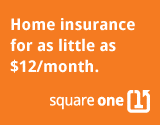Edmonton, AB (Apr. 4, 2019) – With the warmer weather bringing spring showers and snowmelt across the Prairies, also comes the threat of flooding. The spring flood outlook indicates that this year’s flood levels will be at or marginally above levels seen across the Prairies in 2009, the second-highest since the Red River Floodway was constructed. Insurance Bureau of Canada (IBC) is offering tips to help homeowners prepare for flood season.
Flooding and severe weather events have been on the rise across the country with insured damage averaging more than $1.4 billion per year over the last decade.
“When it comes to preparing for severe weather events like flooding, we all have a role to play,” said Celyeste Power, Vice-President, Western, IBC. “IBC is working with governments, consumers and other stakeholders to make homes and communities more resilient to the current weather realities. Helping consumers prepare for these events is part of that.”
Many Canadian insurers now offer residential overland flood insurance which, along with sewer backup coverage, helps reduce the financial risk of these events.
Before a flooding event, IBC is offering advice to help people prepare their homes and prevent damage. Click here for IBC’s Top 10 Tips on flood preparation.
Consumers may also wish to check what types of water damage their insurance policy covers and what additional coverage options are available to them. Here is what is typically covered:
- Damage as a result of sewer backup may be covered by home insurance if the coverage was purchased as an add-on to the home insurance policy. Varying amounts of sewer backup coverage are available. Check with your insurance representative to see if you have this type of coverage and, if so, how much coverage you purchased.
- Not all home insurance policies in Canada cover overland flooding and only some offer coverage for groundwater seepage.
- Overland flooding usually occurs when bodies of water, such as rivers, streams, lakes, dams and other watercourses, overflow onto dry land and cause damage.
Following a flood event, when it is safe to do so, consumers can take these steps to begin the insurance claims process:
- Assess and document potential damage. Taking photos can be helpful.
- Call your insurance representative to report damages or losses.
- Keep good notes and be as detailed as possible when providing information. Be sure to keep all receipts related to cleanup.
- Contact IBC’s Consumer Information Centre at 1-844-2ask-IBC (1-844-227-5422) if you need more information about home, business or car insurance.
For more information on how to protect property against severe weather, floods and other disasters, visit IBC’s website.
About Insurance Bureau of Canada
Insurance Bureau of Canada (IBC) is the national industry association representing Canada’s private home, auto and business insurers. Its member companies make up 90% of the property and casualty (P&C) insurance market in Canada. For more than 50 years, IBC has worked with governments across the country to help make affordable home, auto and business insurance available for all Canadians. IBC supports the vision of consumers and governments trusting, valuing and supporting the private P&C insurance industry. It champions key issues and helps educate consumers on how best to protect their homes, cars, businesses and properties.
P&C insurance touches the lives of nearly every Canadian and plays a critical role in keeping businesses safe and the Canadian economy strong. It employs more than 126,000 Canadians, pays $9 billion in taxes and has a total premium base of $54.7 billion.
For more information, visit www.ibc.ca.
SOURCE: Alberta RCMP via Insurance Bureau of Canada (IBC)
Tags: flood, flood resilience, Insurance Bureau of Canada (IBC)


